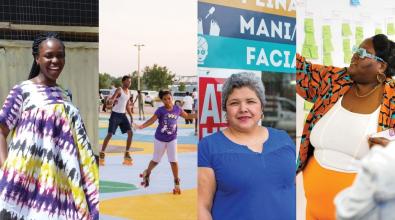This social entrepreneur won $100 million for her effective approach to combating homelessness. Her lessons resonate for city leaders.
Insights from Rosanne Haggerty, whose Built for Zero movement is changing the ways cities tackle homelessness.

Rosanne Haggerty’s approach to homelessness is so promising that it earned the organization she leads a $100 million grant from the MacArthur Foundation to end homelessness in 75 communities across America.
It’s an approach that is deeply rooted in collaboration, data, and design-based innovation—all critical capacities that Bloomberg Philanthropies helps local governments master.
Haggerty is president and chief executive officer of the nonprofit Community Solutions. Her Built for Zero movement is grounded in the push to achieve “functional zero” as a measurable milestone for key populations such as veterans, meaning that homelessness, when it occurs, is rare and brief. Already, 14 communities have achieved this goal for at least one population, and 44 have achieved measurable reductions in homelessness.
Haggerty sat down with Bloomberg Cities to discuss how those cities are deploying innovation tools in their quest to eliminate homelessness in their communities. Here are three lessons she had to share:
Effective collaboration requires a singular focus—and infrastructure to sustain it.
Resources and services directed toward homelessness have historically been fragmented across jurisdictions and sectors, and progress has too often been measured by the amount of money thrown at the problem. To make progress, Haggerty says, all the players need to unite around a single goal of getting to functional zero.
“What changes the trajectory—and what those communities that are succeeding and seeing reductions are doing—is treating homelessness almost like a public-health emergency or an emergency-management problem,” she says. “These communities understand it as a collective-action problem. They’ve got all the agencies, institutions, and actors aligned toward a single goal of getting to functional-zero homelessness. They’ve got their arms around the dynamics of the problem. They know, in real time, how many people are affected, who they are, and they are making decisions based on that live data.”
Haggerty stresses that collaboration around complex problems like homelessness doesn’t happen on its own. Making it work, and keeping it going, requires intentionality and structure. “There needs to be some backbone infrastructure everywhere,” Haggerty says of collaborations targeting homelessness. “Someone must organize it, resource it with data, and provide follow-up support and hold people to their commitments. It’s critical to have someone in that coordinator role, who is empowered to keep the team moving. There must be consistent reflection on what’s working and what isn’t, to continue to iterate and improve. “
Good data can be the ‘tipping point.’
It’s critical for the various groups working on homelessness to know everyone who’s experiencing it by name, in real time, in one information system, Haggerty says. Without data at that level of detail, she says, it’s impossible for communities to problem solve around each individual’s circumstances. “Individual data that’s complete, accurate, timely, and privacy protected better enables each individual or household to be served,” she adds. “This by-name data, we have found, has been so critical for communities to actually see what’s going on and where there are opportunities for significant improvement.”
At the same time, high-level data showing overall trends and trajectories is also important. “You also have the capacity to zoom up to that collective aggregate, so you can see whether what you’re doing as a community is working,” Haggerty says. “Are you slowing down inflow? Are you speeding up housing placements? Communities that have gotten to functional zero already have that shared aim and have their data together in this new standard. It allows communities to put their resources in more impactful places.”
As an example, Haggerty cites Rockford, Ill.—the first community to get to functional zero homelessness among the veteran community, and then among the chronically homeless. “Getting to quality data was, in some ways, the tipping point because it forced folks to collaborate think about outreach in new ways.”
Design interventions around peoples’ lived experiences.
One tool that has been particularly powerful in combating homelessness, Haggerty says, is human-centered design. That’s a method of deeply understanding a problem from the perspective of those experiencing it, and building solutions around their needs. For example, when Sacramento , Calif., engaged people with lived experience of homelessness in mapping the system for getting housed, they spotted opportunities for streamlining the process that had not been identified earlier. Partners with lived experience of homelessness also are now employed as counselors for people in crisis. Since those changes were made, family housing placements went up from 7 in 2022 to 82 so far this year.
“If you have human-centered design in your toolbox, you go to the people experiencing the problem and really understand it in new ways that upends your assumptions and yields pragmatic insights,” Haggerty says. “Human-centered design helps you learn about how the systems we have built around vulnerable people are often themselves the problem. It opens up a much wider array of solutions to people’s housing needs than the commonly imagined ones.”
Haggerty’s Community Solutions outlines four steps for elected officials who want to take action to measurably end homelessness. Learn more here.


